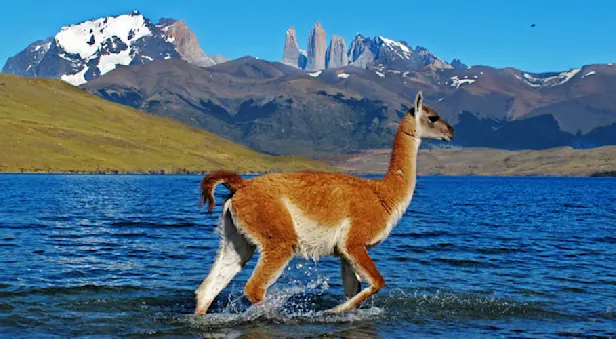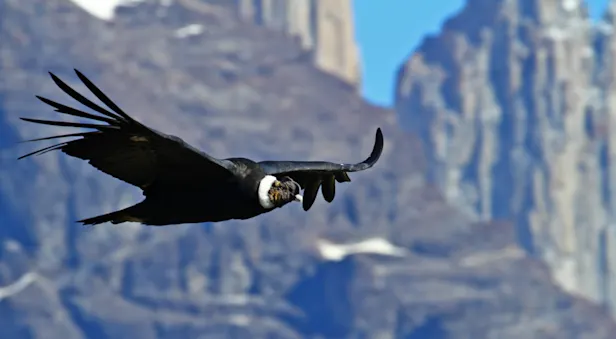Lesser Rhea Facts | Patagonia Wildlife Guide
PHYSICAL DESCRIPTION
The lesser rhea, also known as Darwin’s rhea, stands at about 3 feet in height and weighs between 33 and 55 pounds. With the appearance of a small ostrich, it is at times referred to as the South American ostrich. The rhea has the largest wings in proportion to its body of all ratites.
The rhea is an adept runner, balancing with its wings spread like sails. A talon on each wingtip is used as a defense mechanism, and unlike most birds, rheas have three toes. Their brown plumage, flecked with white, consists of smooth, soft feathers. Females are drabber than males with fewer white speckles, and juveniles entirely lack these white flecks, not obtaining them until 3 to 4 years of age.
GEOGRAPHIC RANGE
Darwin’s rhea is found exclusively in the open scrublands of Patagonia and the Altiplano of South America. They range across the steppes and Puna grassland of the Andean plateau. Though they inhabit arid regions, they often breed near bodies of water such as lakes, swamps and rivers.
FEEDING HABITS
Lesser rheas feed on broad-leafed plants as well as fruits, seeds and roots. They also consume insects, small rodents, and lizards. Rhea’s gain most of their water supply from the plants they ingest. Vegetation is abundant year round in the grasslands where they roam, so they are never far from a meal.
BEHAVIOR
Lesser rheas are quite sociable creatures, forming mixed groups of 5 to 30 members. During the mating season, however, males become aggressive and territorial, and receptive females cluster in groups. In old age, some males wander off to live a solitary existence. Though social, rheas keep a fair distance between each other while sitting, lest they be met with threatening displays of head-jutting and open-billed hissing.
Rheas’ keen eyes and ears alert them to potential threats, and they quickly outrun potential predators, able to attain speeds of 37 miles per-hour. Though swift, these giant birds have low stamina. They run with their wings folded and long necks held low to agilely navigate through bushes. When fleeing, they run in a zigzag pattern or turn their course sharply at a 90-degree angle to confuse pursuers. Displaying another escape tactic, they flatten their bodies against the earth under cover of brush and, despite their size, go entirely undetected. They are adept swimmers while crossing rivers. Lesser rheas are diurnal, with the exception of very hot days. They will sometimes forage with other species, and this relationship aids in predator detection, as the rhea combines its sharp eyesight with the other herbivores astute sense of smell.
REPRODUCTION
At the onset of the rhea’s mating season, males battle over territories. Once obtaining a nesting site, they begin attracting females by swiftly running toward them with wings outstretched. After gathering between 2 and 12 females, the male encircles them in a courtship display, calling out and flapping his wings as he runs. He breeds with the female group and takes them to a nest, where they consecutively lay their eggs. The female group then departs, returning every few days to lay more eggs. Once all the eggs are deposited, ranging in number from 13 to 30, the females leave once again. They head off to breed with another male and make ready to lay eggs in another nest. The male is left to incubate and raise his hatchlings alone. He incubates the eggs for 35 to 40 days, fiercely wary of any animal that approaches, including females coming to lay more eggs. In response to this aggressiveness, the females will often lay their eggs nearby, rather than directly in the nest.
After the first chick hatches, it starts to cry out, which encourages the others to hatch. In a span of 24 to 28 hours, all the hatchlings appear, downy gray-brown with black stripes. The male leads the chicks into the brush after a few days’ time, and they communicate with one another through whistles. If a chick is frightened or too cold or hot, it shelters in the safety of its father’s wings. The highly protective male will often adopt lost chicks, leading to substantial age differences within the group. Fathers care for their chicks for six months, but young may stay in a group up until they reach sexual maturity at 2 or 3 years old. The lesser rhea survives an average of 20 years in the wild but can live up to 40 in captivity.
CONSERVATION STATUS
Darwin’s rhea is poached for its soft feathers, large eggs and meat. Its skin is made into rugs, and body parts are used in traditional medicine. The rhea’s habitat is being fragmented due to large-scale conversion of grasslands to agriculture and pasture for cattle-grazing.
See Lesser Rheas on These Patagonia Adventures

Patagonia Wilderness & Wildlife Explorer
An all-encompassing expedition straddling Chile and Argentina! Marvel at the granite spires of Torres del Paine, survey the vast ice face of Perito Moreno Glacier, search for pumas and see condors soar.
































